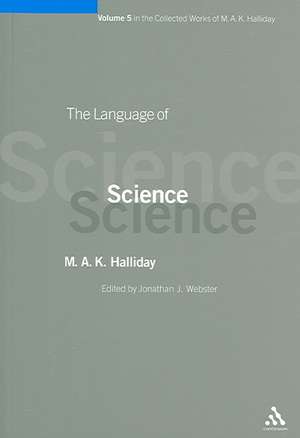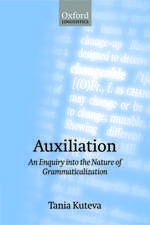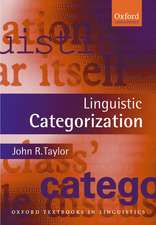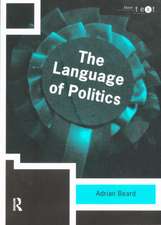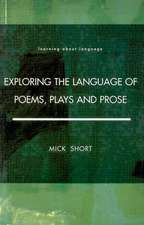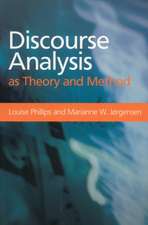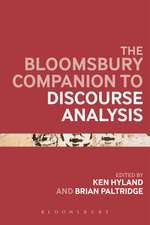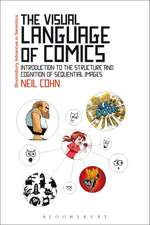Language of Science: Volume 5: Collected Works of M.A.K. Halliday
Editat de Jonathan J. Webster Autor M. A. K. Hallidayen Limba Engleză Paperback – 18 iun 2006
| Toate formatele și edițiile | Preț | Express |
|---|---|---|
| Paperback (1) | 496.21 lei 6-8 săpt. | |
| Bloomsbury Publishing – 18 iun 2006 | 496.21 lei 6-8 săpt. | |
| Hardback (1) | 1124.84 lei 6-8 săpt. | |
| Bloomsbury Publishing – 19 iun 2004 | 1124.84 lei 6-8 săpt. |
Preț: 496.21 lei
Preț vechi: 557.54 lei
-11% Nou
Puncte Express: 744
Preț estimativ în valută:
94.96€ • 103.11$ • 79.77£
94.96€ • 103.11$ • 79.77£
Carte tipărită la comandă
Livrare economică 23 aprilie-07 mai
Preluare comenzi: 021 569.72.76
Specificații
ISBN-13: 9780826488275
ISBN-10: 0826488277
Pagini: 268
Dimensiuni: 156 x 234 x 15 mm
Greutate: 0.41 kg
Editura: Bloomsbury Publishing
Colecția Continuum
Seria Collected Works of M.A.K. Halliday
Locul publicării:London, United Kingdom
ISBN-10: 0826488277
Pagini: 268
Dimensiuni: 156 x 234 x 15 mm
Greutate: 0.41 kg
Editura: Bloomsbury Publishing
Colecția Continuum
Seria Collected Works of M.A.K. Halliday
Locul publicării:London, United Kingdom
Caracteristici
Halliday is one of the most celebrated linguists in the world, having come up with the widely used theory of Systemic Functional Linguistics.
Cuprins
Introduction: How Big is a Language? Part One: Grammatical Metaphor 1. Language and the Reshaping of Human Experience 2. Language and Knowledge: the 'Unpacking' of Text 3. Things and Relations: Regrammaticizing Experience as Technical Knowledge 4. The Grammatical Construction of Scientific Knowledge: the Framing of the English Clause Part Two: Scientific English 5. On the Language of Physical Science 6. Some Grammatical Problems in Scientific English 7. On the Grammar of Scientific English 8. Writing Science: Literacy and Discursive Power
Recenzii
'Halliday's investigations into grammatical metaphor take us deeply into the way we construct and expand meanings, starting with representations of concrete experienced events and ending with a theoretical worlds populated by abstract entities linked through generalized relations and causalities. He finds these processes most strikingly in the development of the modern sciences that have historically created robust virtual worlds of theory from the observable material events of the world. But he sees these same processes in all the meaning systems of modern life, whether law, bureaucracy, economics, or arts. He sees the same processes of grammatical metaphor as children learn to participate in our built symbolic environment, particularly as they are introduced to these meaning systems in schools, an institution designed expressly for that purpose. The linguistic mechanisms Halliday identifies are congruent with Vygotsky's studies of how words come to direct our minds and perception, as individuals and societies. He shares with Vygotsky an understanding of how schooled or scientific concepts re-form the spontaneous concepts of everyday activity to sublate prior experience into higher degrees of abstraction. Both provide related accounts of how cultural history becomes embedded in the complex languages used in scientific, disciplined, or other cultural settings, so that we learn to think with the tools culture provides us, using our own aptitude for metaphorical thinking.' Professor Charles Bazerman, University of California, Santa Barbara.
'These four volumes (4, 5, 6 and 7) venture into remarkably diverse fields. How one man could master the minutiae of all these areas of linguistic research is a matter for wonder and admiration. As a linguistic polymath, Halliday far outstrips all contemporaries...One need look for no further explanation of Halliday's current stature as doyen of British linguistics. The publication of Halliday's complete papers is an important contribution to scholarly documentation.'
'These four volumes (4, 5, 6 and 7) venture into remarkably diverse fields. How one man could master the minutiae of all these areas of linguistic research is a matter for wonder and admiration. As a linguistic polymath, Halliday far outstrips all contemporaries...One need look for no further explanation of Halliday's current stature as doyen of British linguistics. The publication of Halliday's complete papers is an important contribution to scholarly documentation.'
